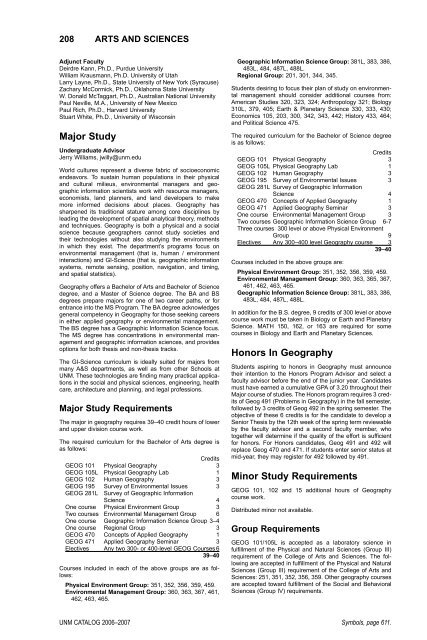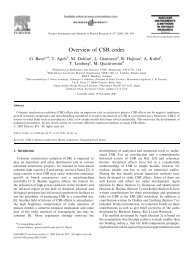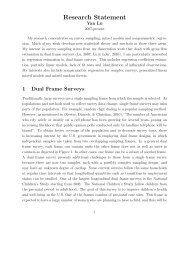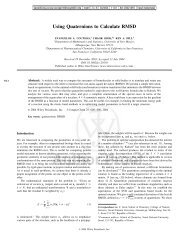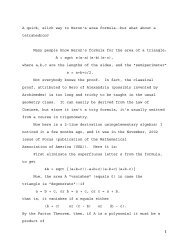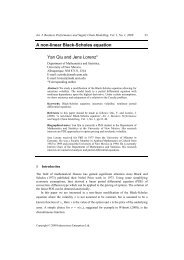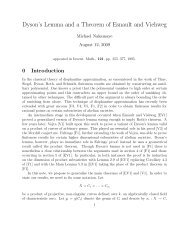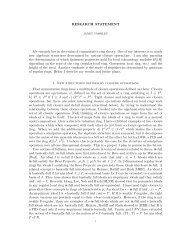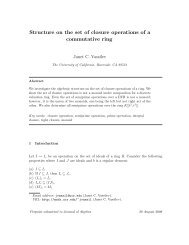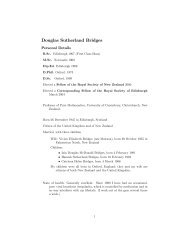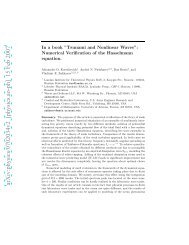OEO Office of Equal Opportunity - Department of Mathematics and ...
OEO Office of Equal Opportunity - Department of Mathematics and ...
OEO Office of Equal Opportunity - Department of Mathematics and ...
You also want an ePaper? Increase the reach of your titles
YUMPU automatically turns print PDFs into web optimized ePapers that Google loves.
208 ARTS AND SCIENCES<br />
Adjunct Faculty<br />
Deirdre Kann, Ph.D., Purdue University<br />
William Krausmann, Ph.D. University <strong>of</strong> Utah<br />
Larry Layne, Ph.D., State University <strong>of</strong> New York (Syracuse)<br />
Zachary McCormick, Ph.D., Oklahoma State University<br />
W. Donald McTaggart, Ph.D., Australian National University<br />
Paul Neville, M.A., University <strong>of</strong> New Mexico<br />
Paul Rich, Ph.D., Harvard University<br />
Stuart White, Ph.D., University <strong>of</strong> Wisconsin<br />
Major Study<br />
Undergraduate Advisor<br />
Jerry Williams, jwilly@unm.edu<br />
World cultures represent a diverse fabric <strong>of</strong> socioeconomic<br />
endeavors. To sustain human populations in their physical<br />
<strong>and</strong> cultural milieus, environmental managers <strong>and</strong> geographic<br />
information scientists work with resource managers,<br />
economists, l<strong>and</strong> planners, <strong>and</strong> l<strong>and</strong> developers to make<br />
more informed decisions about places. Geography has<br />
sharpened its traditional stature among core disciplines by<br />
leading the development <strong>of</strong> spatial analytical theory, methods<br />
<strong>and</strong> techniques. Geography is both a physical <strong>and</strong> a social<br />
science because geographers cannot study societies <strong>and</strong><br />
their technologies without also studying the environments<br />
in which they exist. The department’s programs focus on<br />
environmental management (that is, human / environment<br />
interactions) <strong>and</strong> GI-Science (that is, geographic information<br />
systems, remote sensing, position, navigation, <strong>and</strong> timing,<br />
<strong>and</strong> spatial statistics).<br />
Geography <strong>of</strong>fers a Bachelor <strong>of</strong> Arts <strong>and</strong> Bachelor <strong>of</strong> Science<br />
degree, <strong>and</strong> a Master <strong>of</strong> Science degree. The BA <strong>and</strong> BS<br />
degrees prepare majors for one <strong>of</strong> two career paths, or for<br />
entrance into the MS Program. The BA degree acknowledges<br />
general competency in Geography for those seeking careers<br />
in either applied geography or environmental management.<br />
The BS degree has a Geographic Information Science focus.<br />
The MS degree has concentrations in environmental management<br />
<strong>and</strong> geographic information sciences, <strong>and</strong> provides<br />
options for both thesis <strong>and</strong> non-thesis tracks.<br />
The GI-Science curriculum is ideally suited for majors from<br />
many A&S departments, as well as from other Schools at<br />
UNM. These technologies are finding many practical applications<br />
in the social <strong>and</strong> physical sciences, engineering, health<br />
care, architecture <strong>and</strong> planning, <strong>and</strong> legal pr<strong>of</strong>essions.<br />
Major Study Requirements<br />
The major in geography requires 39–40 credit hours <strong>of</strong> lower<br />
<strong>and</strong> upper division course work.<br />
The required curriculum for the Bachelor <strong>of</strong> Arts degree is<br />
as follows:<br />
Credits<br />
GEOG 101 Physical Geography 3<br />
GEOG 105L Physical Geography Lab 1<br />
GEOG 102 Human Geography 3<br />
GEOG 195 Survey <strong>of</strong> Environmental Issues 3<br />
GEOG 281L Survey <strong>of</strong> Geographic Information<br />
Science 4<br />
One course Physical Environment Group 3<br />
Two courses Environmental Management Group 6<br />
One course Geographic Information Science Group 3–4<br />
One course Regional Group 3<br />
GEOG 470 Concepts <strong>of</strong> Applied Geography 1<br />
GEOG 471 Applied Geography Seminar 3<br />
Electives Any two 300- or 400-level GEOG Courses 6<br />
39–40<br />
Courses included in each <strong>of</strong> the above groups are as follows:<br />
Physical Environment Group: 351, 352, 356, 359, 459.<br />
Environmental Management Group: 360, 363, 367, 461,<br />
462, 463, 465.<br />
Geographic Information Science Group: 381L, 383, 386,<br />
483L, 484, 487L, 488L.<br />
Regional Group: 201, 301, 344, 345.<br />
Students desiring to focus their plan <strong>of</strong> study on environmental<br />
management should consider additional courses from:<br />
American Studies 320, 323, 324; Anthropology 321; Biology<br />
310L, 379, 405; Earth & Planetary Science 330, 333, 430;<br />
Economics 105, 203, 300, 342, 343, 442; History 433, 464;<br />
<strong>and</strong> Political Science 475.<br />
The required curriculum for the Bachelor <strong>of</strong> Science degree<br />
is as follows:<br />
Credits<br />
GEOG 101 Physical Geography 3<br />
GEOG 105L Physical Geography Lab 1<br />
GEOG 102 Human Geography 3<br />
GEOG 195 Survey <strong>of</strong> Environmental Issues 3<br />
GEOG 281L Survey <strong>of</strong> Geographic Information<br />
Science 4<br />
GEOG 470 Concepts <strong>of</strong> Applied Geography 1<br />
GEOG 471 Applied Geography Seminar 3<br />
One course Environmental Management Group 3<br />
Two courses Geographic Information Science Group 6-7<br />
Three courses 300 level or above Physical Environment<br />
Group 9<br />
Electives Any 300–400 level Geography course 3<br />
39–40<br />
Courses included in the above groups are:<br />
Physical Environment Group: 351, 352, 356, 359, 459.<br />
Environmental Management Group: 360, 363, 365, 367,<br />
461, 462, 463, 465.<br />
Geographic Information Science Group: 381L, 383, 386,<br />
483L, 484, 487L, 488L.<br />
In addition for the B.S. degree, 9 credits <strong>of</strong> 300 level or above<br />
course work must be taken in Biology or Earth <strong>and</strong> Planetary<br />
Science. MATH 150, 162, or 163 are required for some<br />
courses in Biology <strong>and</strong> Earth <strong>and</strong> Planetary Sciences.<br />
Honors In Geography<br />
Students aspiring to honors in Geography must announce<br />
their intention to the Honors Program Advisor <strong>and</strong> select a<br />
faculty advisor before the end <strong>of</strong> the junior year. C<strong>and</strong>idates<br />
must have earned a cumulative GPA <strong>of</strong> 3.20 throughout their<br />
Major course <strong>of</strong> studies. The Honors program requires 3 credits<br />
<strong>of</strong> Geog 491 (Problems in Geography) in the fall semester,<br />
followed by 3 credits <strong>of</strong> Geog 492 in the spring semester. The<br />
objective <strong>of</strong> these 6 credits is for the c<strong>and</strong>idate to develop a<br />
Senior Thesis by the 12th week <strong>of</strong> the spring term reviewable<br />
by the faculty advisor <strong>and</strong> a second faculty member, who<br />
together will determine if the quality <strong>of</strong> the effort is sufficient<br />
for honors. For Honors c<strong>and</strong>idates, Geog 491 <strong>and</strong> 492 will<br />
replace Geog 470 <strong>and</strong> 471. If students enter senior status at<br />
mid-year, they may register for 492 followed by 491.<br />
Minor Study Requirements<br />
GEOG 101, 102 <strong>and</strong> 15 additional hours <strong>of</strong> Geography<br />
course work.<br />
Distributed minor not available.<br />
Group Requirements<br />
GEOG 101/105L is accepted as a laboratory science in<br />
fulfillment <strong>of</strong> the Physical <strong>and</strong> Natural Sciences (Group III)<br />
requirement <strong>of</strong> the College <strong>of</strong> Arts <strong>and</strong> Sciences. The following<br />
are accepted in fulfillment <strong>of</strong> the Physical <strong>and</strong> Natural<br />
Sciences (Group III) requirement <strong>of</strong> the College <strong>of</strong> Arts <strong>and</strong><br />
Sciences: 251, 351, 352, 356, 359. Other geography courses<br />
are accepted toward fulfillment <strong>of</strong> the Social <strong>and</strong> Behavioral<br />
Sciences (Group IV) requirements.<br />
UNM CATALOG 2006–2007 Symbols, page 611.


